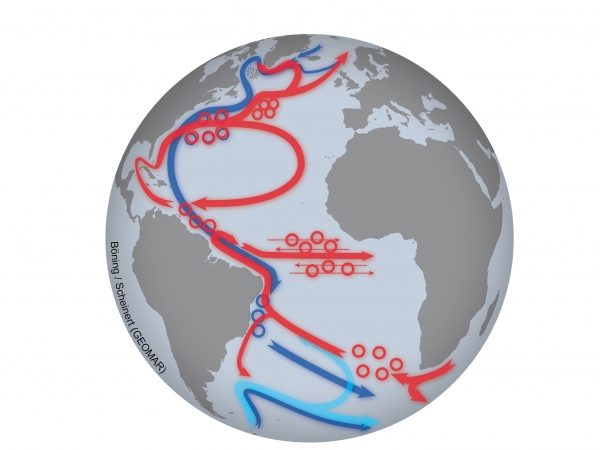The Gulf Stream system plays an important role in climate. The weakening of this system that has been observed over the last two decades is therefore a cause for concern and much debate. The question is whether the measurable changes are already due to human-induced climate change - model simulations predict such an influence with high probability for the future. A new study by scientists at the GEOMAR Helmholtz Centre for Ocean Research in Kiel, Germany, now published in the journal Nature Communications, concludes that the currently observed weakening can be interpreted, at least in part, as a natural fluctuation following some extremely cold winters in the Labrador Sea in the 1990s.
The Gulf Stream, which brings warm water from the Gulf of Mexico to Europe and keeps the climate mild, is only part of a larger system of oceanic currents called the Atlantic Meridional Overturning Circulation, or AMOC for short. It runs through the Atlantic like a giant climate machine: as warm water from the tropics is transported northwards at the surface, the current reverses in the North Atlantic – the water cools, becomes heavier and flows south at depth.
Where exactly these sinking processes take place is the subject of current research, and recent measurement programmes have located them to the east of Greenland. A team of scientists from the GEOMAR Helmholtz Centre for Ocean Research in Kiel, Germany, has now conducted a modelling study of the Labrador Sea southwest of Greenland. In their study, now published in the journal Nature Communications, the researchers used complex computer simulations to show that fluctuations in the Labrador Sea can have a significant influence on the strength of sinking processes east of Greenland. An important link is a little-noticed system of deep currents that ensures the rapid spread of Labrador Sea water into the deep-sea basin between Greenland and Iceland.
Read more at Helmholtz Centre for Ocean Research Kiel (GEOMAR)
Image: Schematic of surface (red) and deep (blue) currents in the Atlantic Ocean. Circles indicate regions where currents are strongly influenced by oceanic eddies. The dashed area between Canada and Greenland outlines the area in the Labrador Sea where strong winter cooling causes vertical mixing of the water column. (Graphic: Böning / Scheinert (GEOMAR))


